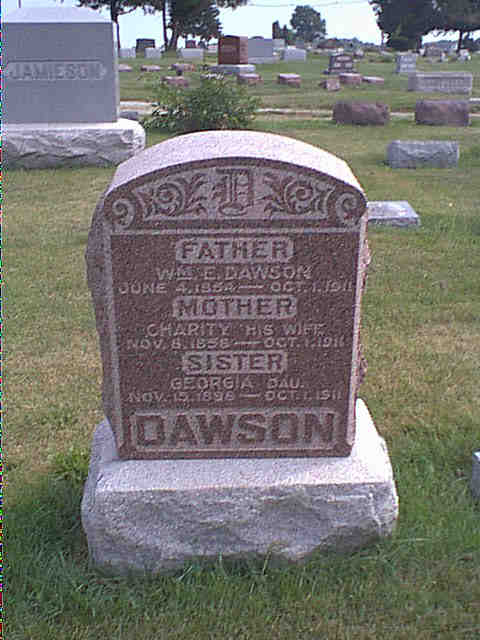
During the last year I have doing my best to track down more information about William Dawson and his family. I have come up with nothing I didn’t already know. You can read about that here. Instead of rehashing the

The photo above is the former location of the Dawson's house as seen through Google Maps. The blue line indicates the direction the killer went after the murders. To the north of the house is the section of the railroad tracks nearest the house. It’s approximately a half mile way. The portion of town south of those tracks was referred to by locals as the “colored section” of town, indicating a high concentration of black families. Now I don’t know what the ratio of black to white households in that part of town were in 1911 but it probably leaned heavily toward black since this was also where the brand new “colored church” was located (right across the street from the Dawson’s home in fact). The question I have is this; what are the odds a killer would pick, at random, one of the few white families in a heavily black community? Just something I think about…
The Monmouth crime has something in common with Villisca besides the obvious things. Both in Villisca and Monmouth the crime scenes were located quite a bit farther away from the railroad tracks then at the other crime scenes. In Colorado Springs, the tracks were just a half a block away; in Ellsworth they were almost in the front yard of the house and in Paola they were only a few houses away. If the killer was utilizing the railroad to make his escape then he needed to walk quite a ways through both Villisca and Monmouth before getting to the tracks where he likely escaped from town. Does this indicate the killer had some knowledge of at least those two towns?
If there are any descendants of William and Charity Dawson who are reading this post, I would be very interested in hearing from you.

6 comments:
@Inspector-Although Kelly can pretty much be dismissed as an attention seeking pervert in the Villisca case (and although there were signs of sexual perversion; i.e. the one Stillinger girl and the bacon) and Jones may have had motive in the Villisca case it hardly ties him to the other sites. His hired man Mansfield may have been more prolific than the one instance but the one case he CAN be tied to had gain as a motive. Does anyone know whether robbery was involved in any of the cases? I know the crowds ruined the investigation of several of the sites and even stole momentos but was there any proof of actual robbery? If not, and we assume that several of the cases were linked than the motive would be misogynism. Loving Mitchell was arrested for the Monmouth case as a flashlight he dropped by the back fence had "colo springs 11 Lovey" carved into it. He used a pipe with an elbow that some might consider rules him out but the murderer or murderers seemed to use what implements came to hand. This would link him to the two...and if he was suspected of the Colorado Springs case a SECOND household was involved and the similarity would at LEAST point to the houses where a second break-in was attempted. Does anyone know what happened to Loving Mitchell? He was said to have two compatriots. I have found no instance other than old papers where it was speculated he could be involved in several.
Anonymous - I moved your comment to this post because of it's relation to Monmouth. 1) Robbery was not considered a motive in any of the crimes. 2) F.F. Jones and William Mansfield had never seen nor heard of each other until Detective Wilkerson's conspiracy theory threw them together. 3) Lovie Mitchell was the victim of an acquaintance trying to get a lighter prison sentence.
The similarities between the Colo Springs murders, Ellsworth and Paola would seem to point towards a serial killing. What of the flashlight found by the fence? Was this an invention? Is the Ellsworth site still standing?
I've read several differing accounts of the Mitchell flashlight.
@ Inspector- You've been a wealth of info on the different sites and cases. Thank you
I've recently been to the Dawson house, which still stands, and am familiar with the area. The "colored church" actually sat next to the Dawson house, and had been recently built. It was to have it's dedication ceremony the day the murders were discovered, in fact Mrs. Dawson took issue with some of the churchgoers the night before because they were coming into their yard and cutting her flowers to decorate the church with. It's been reported that the crowds that gathered around the house after the discovery of the bodies, hampered the new church's ceremony.
The pond where the gas pipe was found, was known as a railroad pond and the tracks run within feet of the southern edge of it. It's been extended to the north and is now known as Citizen's Lake. I wouldn't think it would be much of a stretch to think that the gas pipe could have been found in a refuse pile created by the construction of the new church.
Post a Comment